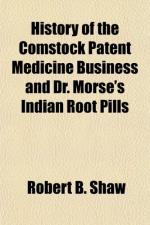|
This section contains 1,571 words (approx. 6 pages at 300 words per page) |

|
Patent medicines first appeared in England in the 1600s. When a medication was patented, its formula was owned by the patent holder, and no one else could duplicate and sell it. In order to qualify for a patent, a medicine only had to be original; no proof of effectiveness or safety was required. Because the ingredients of patented remedies had to be listed, many sellers of proprietary medications never applied for patents. Instead, they registered distinctive trade names in order to market their nostrum--ingredients unspecified--under a unique brand name. In time, all of these medicines being promoted for public sale became known as "patent" medicines, whether they were in fact patented or not. Most were promoted as astonishingly effective cures for an equally astonishing range of maladies. For example, this 1800s advertisement for Dr. Jayne's Alternative claims the following cures:
For the cure of Scrofula, King's...
|
This section contains 1,571 words (approx. 6 pages at 300 words per page) |

|


